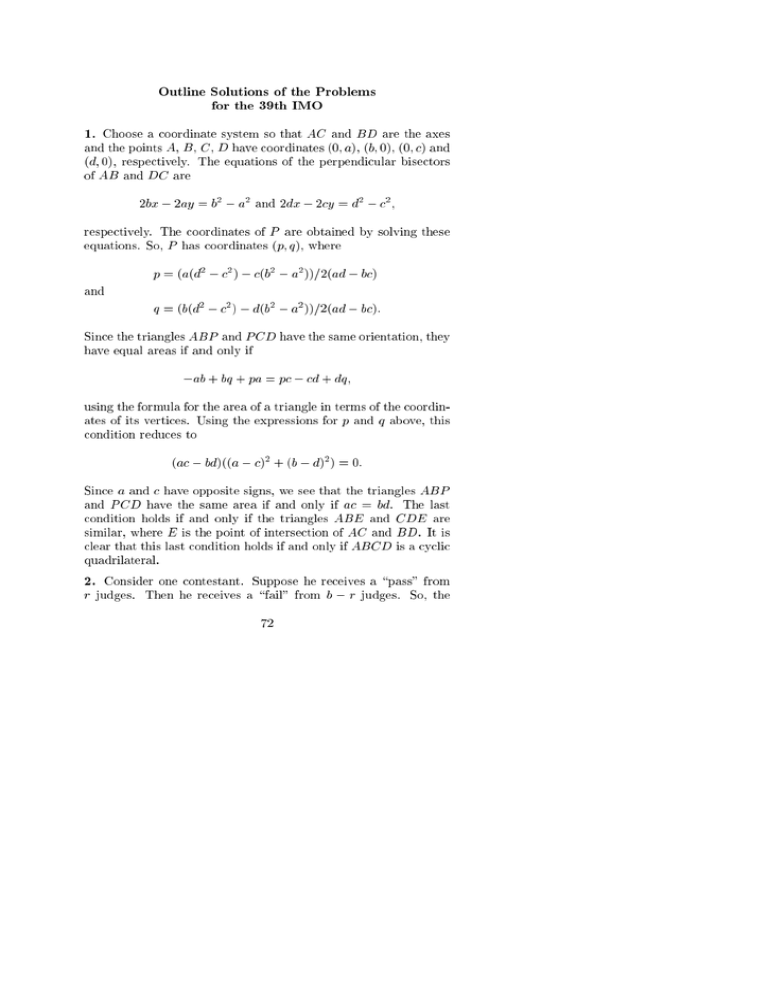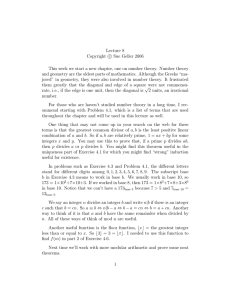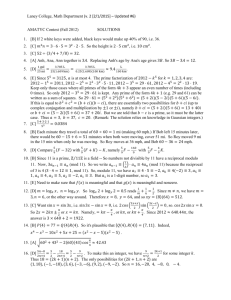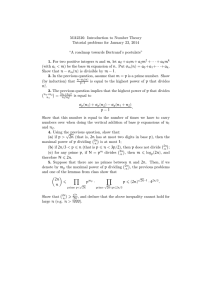Document 11012139
advertisement

Outline Solutions of the Problems for the 39th IMO Choose a oordinate system so that AC and BD are the axes and the points A, B , C , D have oordinates (0; a), (b; 0), (0; ) and (d; 0), respetively. The equations of the perpendiular bisetors of AB and DC are 1. 2bx 2ay = b2 a 2 and 2dx 2y = d2 2 ; respetively. The oordinates of P are obtained by solving these equations. So, P has oordinates (p; q ), where p = (a(d2 q = (b(d2 and 2) b (2 a 2) d b 2 ))=2(ad b (2 a 2 ))=2(ad b : ) ) Sine the triangles ABP and P C D have the same orientation, they have equal areas if and only if ab + bq + pa = p d + dq; using the formula for the area of a triangle in terms of the oordinates of its verties. Using the expressions for p and q above, this ondition redues to (a bd )((a )2 + (b d )2 ) = 0: Sine a and have opposite signs, we see that the triangles ABP and P C D have the same area if and only if a = bd. The last ondition holds if and only if the triangles ABE and C DE are similar, where E is the point of intersetion of AC and BD. It is lear that this last ondition holds if and only if ABC D is a yli quadrilateral. 2. r Consider one ontestant. Suppose he reeives a \pass" from judges. Then he reeives a \fail" from b r judges. So, the 72 IMO Solutions 73 number of pairs of judges who agree for this ontestant is r b + 2 r 2 Thus 1 = (r2 + (b 2 21 ( 12 (r + b r b + 2 r r )2 r ) b 1 ) = ((b 4 )2 b 14 ( b 2 1)2 1): 1)2 : Sine there are 2b pairs of judges and eah pair agrees on at most b k ontestants, the total number of agreements is at most k 2. Sine there are a ontestants, we get k So, b 2 4( a b 1)2 : ( 1)=2 and the result follows. 3. (Solution by Arkady Slinko.) It is easy to see that d is a multipliative funtion and that d(pr ) = r + 1 when p is a prime. So, if the prime fatorization of n is pr11 prmm , then kb a b ( 2 ) (2r1 + 1) (2rm + 1) = : d(n) (r1 + 1) (rm + 1) () d n Let k be a positive integer of the form (). Clearly, k is odd and, when n = 1, we get k = 1. We laim that every odd integer an be represented in the form (). We prove this by indution. Suppose that all odd k0 < k are representable in the form (). Let s k = 2 k0 1, where s and k0 are positive integers and k0 is odd. Sine k0 is representable, it suÆes to prove that (2s k0 1)=k0 an be represented in the form (). Letting m = (2s 1)k0 , we get 2s k0 k 0 1 = = 2s m (2s 1) m 2m m 1 42 m m 3 1 2s 21 s m m (2s 1) ; (2s 1 1) IMS Bulletin 41, 1998 74 a telesoping produt of the form (). The result follows. 4. Sine ( 2 + a + b) b a b ( 2 + b + 7) = b2 a ab 7a; 2 2 2 7a. Now ab + a + b is divisible by ab + b + 7, then so is b 2 2 2 2 b 7a < ab + b +7 and so, if b 7a 0, we get b 7a=0. Thus (a; b) = (7t2 ; 7t), for some positive integer t. On the other hand, if (a; b) = (7t2 ; 7t), for some positive integer t, then ab2 + b + 7 = 7(49t4 + t + 1) divides a2 b + a + b = 7t(49t4 + t + 1). Suppose now that b2 7a < 0. Then ab2 + b + 7 divides the positive integer 7a b2 . If b 3, then ab2 + b + 7 > 9a. Hene if = 1 or b = 2. If b = 1, then a + 8 divides 7a 1 and, sine the multiple is at most 6, we get a = 11 or a = 49. It is easy to see that (a; b) = (11; 1); (49; 1) are solutions to the problem. Finally, if b = 2, then 4a + 9 divides 7a 4 and sine the only possibility is 4a + 9 = 7a 4, we do not get an integer value for a in this ase. So, the omplete list of solutions is: b (11; 1); (49; 1); (7t2; 7t); for all t 2 N : 5. (Solution by Andy Liu.) It is easy to see that 6 and that 6 RM B =6 AM L RBM =6 BM K =6 =6 M KL =6 BK M =6 BS K BS K: So the triangles M RB and K BS are similar. Thus BR BS = 2 . Sine 6 RBM = 6 S BK and I B bisets 6 ABC , the lines I B and RS are perpendiular. Thus BK IR 2 + I S 2 = RB 2 + BS 2 + 2I B 2 2 2 2 > RB + BS + 2BK = RB 2 + BS 2 + 2RB BS = RS 2 So, sine I R2 + I S 2 > RS 2 , the angle RI S is aute. IMO Solutions 75 Let f (n2 (f (m)) = mf (n)2 for all m and n in N . Let f (1) = a. Then 2 2 2 f (f (m)) = a m and f (an ) = f (n) 6. for all m; n 2 N . If f (r) = f (s), then a2 r = f (f (r)) = f (f (s)) = 2 a s and thus r = s, so that f is injetive. Note that f (a) = 2 f (f (1)) = a . Now (f (m)f (n))2 = f (m)2 f (n)2 = f (am2 )f (n)2 = f (n2 f (f (am2 ))) = f (a3 m2 n2 ) = f (a(amn)2 ) = f (amn)2 : So, f (amn) = f (m)f (n). In partiular, f (an) = af (n). Thus ( af mn ) = f (m)f (n) for all m; n 2N : We laim that a divides f (m) for all positive integers m. For suppose that a 6= 1 and let pk be the highest power of the prime 2 2 r p that divides a. Sine af (m ) = f (m) , p divides f (m) for all m, for some integer r k=2. Consider the largest suh r . Then k+r p divides f (m)2 , for all m 2 N . So k + r 2r. Thus r k and hene pk divides f (m) for all m. Thus a divides f (m) for all m. So, there exists a funtion g : N ! N suh that f (n) = ag (n) for all n. Now g (1) = 1 and g (n2 g (m)) = mg (n)2 for all m; n 2 N . Sine g (1998) f (1998), the least possible value of f (1998) for funtions satisfying the given identity will be attained for a funtion f with f (1) = 1. Thus, we need only onsider funtions f : N ! N suh that f (1) = 1 and f (n2 f (m)) = mf (n)2 for all m; n 2 N . Then f (mn) = f (m)f (n) and f (f (m)) = m for all positive integers m and n. Clearly, a funtion f with the last two properties also satises f (1) = 1 and f (n2 f (m)) = mf (n)2 for all positive integers m and n. By the multipliative property, one f (p) is determined for eah prime p, then f will be ompletely determined. Let p be a prime and suppose that f (p) = ab for 76 IMS Bulletin 41, 1998 ertain a; b 2 N . Then p = f (f (p)) = f (ab) = f (a)f (b). We may suppose that f (a) = 1. Then sine f (1) = 1, the injetivity of f implies that a = 1. Thus f (p) is a prime for all primes p and injetivity implies that f maps distint primes to distint primes. Sine 1998 = 2 33 37, to nd a funtion satisfying the given onditions suh that f (1998) is as small as possible, it is lear that letting f (2) = 3; f (3) = 2; f (37) = 5 and for eah other prime p, f (p) equal any prime not already hosen, will produe the required funtion. Thus the minimal possible value for f (1998) is 3 23 5 = 120.





